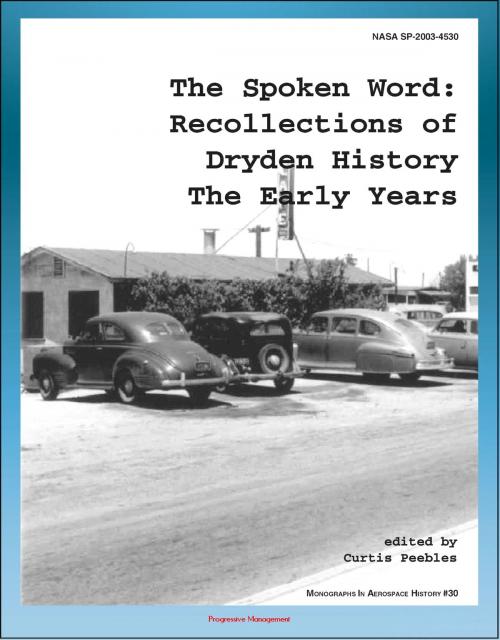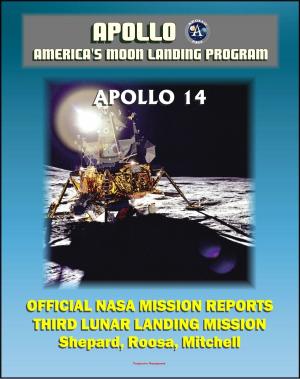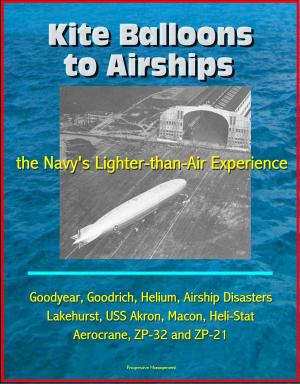The Spoken Word: Recollections of Dryden History, The Early Years (NASA SP-2003-4530) - Scott Crossfield Interview, Muroc, NACA Research, X-1 Project
Nonfiction, Science & Nature, Technology, Aeronautics & Astronautics, History, Military, Aviation| Author: | Progressive Management | ISBN: | 9781476237640 |
| Publisher: | Progressive Management | Publication: | July 19, 2012 |
| Imprint: | Smashwords Edition | Language: | English |
| Author: | Progressive Management |
| ISBN: | 9781476237640 |
| Publisher: | Progressive Management |
| Publication: | July 19, 2012 |
| Imprint: | Smashwords Edition |
| Language: | English |
Since the founding of the Dryden Flight Research Center History Office in 1996, its staff has conducted nearly a hundred interviews with retired and serving employees. Their recollections represent a unique resource in understanding the development of aerospace technology in the second half of the 20th century. Their personal experiences, insights, and opinions allow the reader to gain an understanding into what it was actually like to have been involved with some of the milestone events in aerospace history. These interviews have been edited and assembled into this monograph, so that a wider audience can also share in their experiences.
This study covers the early years of what eventually became the Dryden Flight Research Center. It spans the period between the arrival of Walter Williams and the first group of NACA engineers at Muroc in 1946, and ends with the establishment of NASA in 1958. This timeframe encompasses the breaking of the sound barrier, the pivotal inertial coupling research, the first use of computer simulations, the transformation of the NACA facility from a pair of old hangars into a state-of-the-art research center, and the dawn of the space age. These events took place against the background of the end of World War II, the start of the Cold War, and the twin technological revolutions of jet propulsion and supersonic flight. They are told by the people who participated in these events, in their own words.
The foundations of the Dryden Flight Research Center date back more than a half century, to a time when aviation faced revolutionary technical changes. When the first NACA contingent arrived in September 1946, they found the Muroc Army Air Field to be an isolated and barren outpost. The post-war demobilization had left the hastily constructed base facilities in a poor state of repair. Palmdale and Lancaster in the late 1940s were rough desert towns lacking many of the conveniences to which the new arrivals from Langley (and their spouses) had been accustomed. Farther north lay Mojave, a desolate railroad stop with a gas station, White's Motel, a nightclub, and a pool hall. Rosamond consisted of little more than several bars open around the clock. Agriculture continued to be the primary activity in the Antelope Valley: cattle and grain on the west side, and alfalfa farming on the east.
Section I: Foundations * Walter C. Williams * Clyde Bailey, Richard Cox, Don Borchers, and Ralph Sparks * John Griffith * Betty Love * Section II: A Second Wind * Richard E. Day * Scott Crossfield * Jack Fischel * Stanley P. Butchart * Epilogue * Sources * Acknowledgments
Since the founding of the Dryden Flight Research Center History Office in 1996, its staff has conducted nearly a hundred interviews with retired and serving employees. Their recollections represent a unique resource in understanding the development of aerospace technology in the second half of the 20th century. Their personal experiences, insights, and opinions allow the reader to gain an understanding into what it was actually like to have been involved with some of the milestone events in aerospace history. These interviews have been edited and assembled into this monograph, so that a wider audience can also share in their experiences.
This study covers the early years of what eventually became the Dryden Flight Research Center. It spans the period between the arrival of Walter Williams and the first group of NACA engineers at Muroc in 1946, and ends with the establishment of NASA in 1958. This timeframe encompasses the breaking of the sound barrier, the pivotal inertial coupling research, the first use of computer simulations, the transformation of the NACA facility from a pair of old hangars into a state-of-the-art research center, and the dawn of the space age. These events took place against the background of the end of World War II, the start of the Cold War, and the twin technological revolutions of jet propulsion and supersonic flight. They are told by the people who participated in these events, in their own words.
The foundations of the Dryden Flight Research Center date back more than a half century, to a time when aviation faced revolutionary technical changes. When the first NACA contingent arrived in September 1946, they found the Muroc Army Air Field to be an isolated and barren outpost. The post-war demobilization had left the hastily constructed base facilities in a poor state of repair. Palmdale and Lancaster in the late 1940s were rough desert towns lacking many of the conveniences to which the new arrivals from Langley (and their spouses) had been accustomed. Farther north lay Mojave, a desolate railroad stop with a gas station, White's Motel, a nightclub, and a pool hall. Rosamond consisted of little more than several bars open around the clock. Agriculture continued to be the primary activity in the Antelope Valley: cattle and grain on the west side, and alfalfa farming on the east.
Section I: Foundations * Walter C. Williams * Clyde Bailey, Richard Cox, Don Borchers, and Ralph Sparks * John Griffith * Betty Love * Section II: A Second Wind * Richard E. Day * Scott Crossfield * Jack Fischel * Stanley P. Butchart * Epilogue * Sources * Acknowledgments















